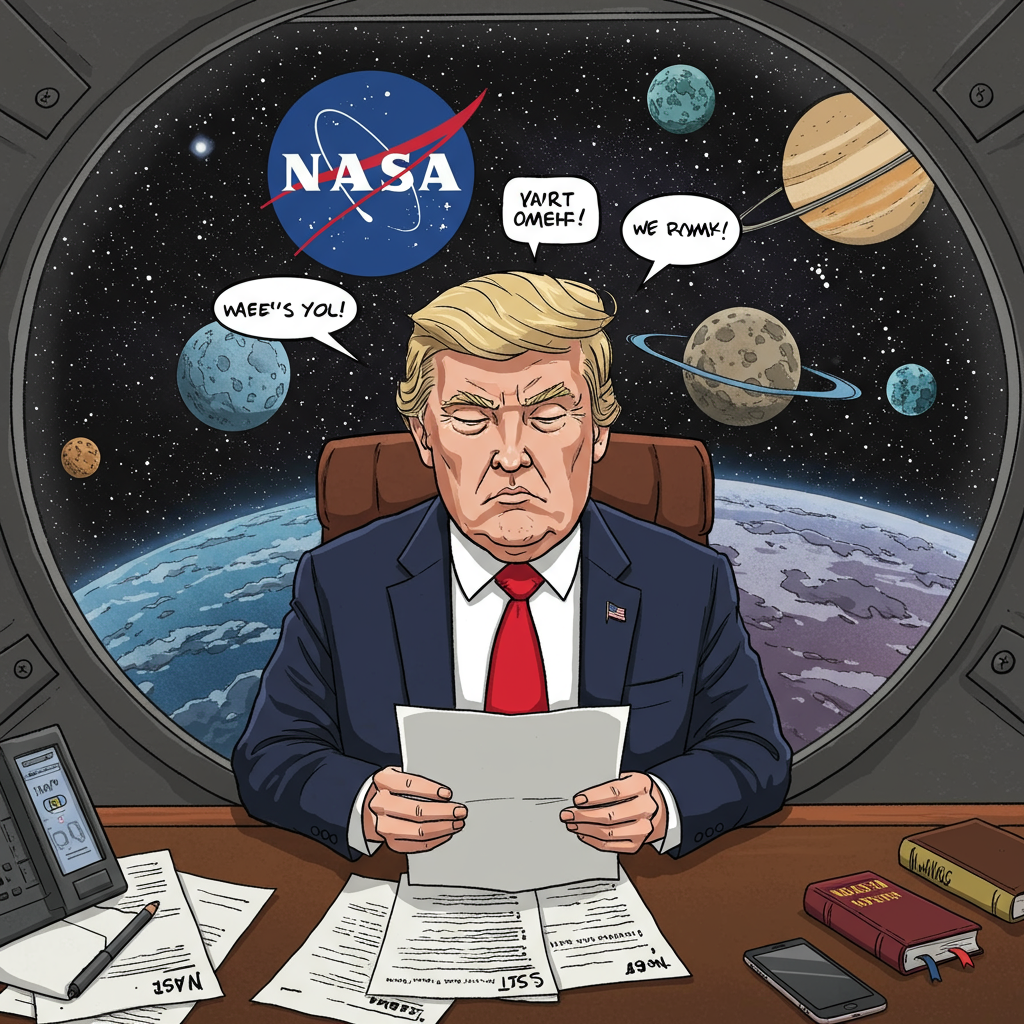Deep space exploration and crucial Earth monitoring require sustained investment and forward-thinking strategy. Yet, a stark warning echoes from the scientific community and former government officials: proposed, drastic reductions to NASA’s science funding could severely undermine American preeminence in space and scientific discovery, potentially clearing a path for competitors like China to surge ahead across the solar system and beyond. This potential shift could mark a significant turning point in the global race for scientific and technological dominance.
The Trump administration has put forward a fiscal year 2026 budget proposal to Congress that targets NASA’s vital science missions for significant termination or curtailment. This proposal suggests slashing NASA’s science budget by nearly half, aiming to drop it from $7.33 billion to just $3.9 billion. The stated rationale is that NASA currently manages an excessively large portfolio of over 100 science programs exceeding $7 billion annually. The proposed budget seeks to cultivate a “leaner, more focused Science program,” emphasizing fiscal prudence amidst competing federal priorities. However, critics argue this approach risks dismantling decades of progress and hard-won expertise, jeopardizing America’s position as a leader in space science.
Potential Devastation to Scientific Exploration
The sheer scale of the proposed budget cuts is alarming. While Congress holds the final decision-making power, initial documents and statements point towards cuts averaging around 47% specifically for the science directorate. Some scientific divisions face even steeper reductions, impacting our understanding of the cosmos and our own planet. Astrophysics funding could plummet by nearly two-thirds, potentially devastating research into extreme cosmic events and the universe’s fundamental mysteries. Heliophysics, dedicated to studying the sun and its profound influence on Earth, might face a similar drastic cut. Earth science, absolutely critical for monitoring climate change, natural disasters, and environmental health, is reportedly slated for over a 50% reduction. While planetary science faces a comparatively smaller 30% cut, this is still a substantial decrease that threatens planned missions and ongoing research about our solar system neighbors, including the crucial search for life beyond Earth.
These proposed cuts have immediate, tangible consequences: the cancellation of numerous established missions and promising initiatives already in development or planning stages. Operational spacecraft, some diligently returning data for years, find themselves on the chopping block. This includes venerable workhorses like the Mars Odyssey orbiter, which has circled the Red Planet since 2001, providing invaluable data and essential relay services for Martian rovers. The MAVEN orbiter, also at Mars studying its atmosphere, and the Juno mission, currently exploring Jupiter, both launched within the last decade, are reportedly marked for cancellation under this proposal. Terminating functional spacecraft prematurely represents a profound waste of billions in taxpayer investment. Mars Odyssey, for instance, cost $218 million to build and launch, but its annual operating cost is a mere $10 million, yielding critical, unique data for a fraction of its initial price. Abandoning such missions means walking away from this value and capability. Experts contend that recreating this capacity later would demand significantly more time and money.
Halting Key Missions and Damaging Collaborations
The proposed budget isn’t solely targeting older missions. It suggests terminating or delaying numerous projects in development, including those identified as top priorities by the scientific community. The Mars Sample Return program, a complex and ambitious joint effort with the European Space Agency (ESA), is a major casualty. This mission aims to bring rock and soil samples collected by the Perseverance rover on Mars back to Earth for detailed laboratory analysis, a long-held goal of planetary science. Abandoning this program would nullify years of international collaboration, significant investment, and dedicated work, harming vital partnerships.
Other missions, including OSIRIS-APEX, which successfully returned asteroid samples and is now en route to study the asteroid Apophis, face termination before completing their extended objectives. Planned missions to explore Venus, such as DaVinci+ and VERITAS – which would mark NASA’s first dedicated return to studying Venus since 1989 and explore its atmosphere and surface – could also be scrapped. Even the Nancy Grace Roman Space Telescope, a nearly $4 billion project already built and undergoing testing for launch next year, is reportedly left unfunded in this proposal, despite being on schedule and on budget. Astrophysicists argue that canceling a project at this late stage, after billions have been spent, is nonsensical. This widespread proposed cancellation of missions is described by some critics, including the Planetary Society’s Casey Dreier, as an “extinction-level event” for NASA science, akin to natural events that wipe out entire ecosystems of discovery. Turning off functional spacecraft and halting promising projects represents a stark strategic retreat from scientific exploration.
Workforce Impact and the Threat of Brain Drain
Beyond missions, the budget proposal outlines a significant reduction in NASA’s workforce. Reports indicate cutting the agency’s staff by approximately one-third, potentially decreasing numbers from over 17,000 to under 12,000. This would shrink NASA’s workforce to its smallest size since the mid-1960s, a period preceding key milestones like the first American spacewalk and the Apollo program. Such widespread job insecurity leads to profoundly low morale among scientists and engineers who are concerned about their careers and the future of their respective fields. NASA officials have reportedly indicated the need to begin downsizing even before Congress finalizes the budget, utilizing early retirement incentives and buyouts, leading hundreds to depart already, with thousands more expressing interest.
The impact of potential workforce reductions is particularly severe at NASA centers heavily focused on science missions. The Jet Propulsion Laboratory (JPL) in Pasadena, California, managed by Caltech, receives billions annually for science projects. Under the proposed budget, its funding could drop significantly, potentially over $1.3 billion. Goddard Space Flight Center in Greenbelt, Maryland, NASA’s largest center employing 7,000 scientists and engineers, could reportedly lose nearly half its workforce, with some reports even circulating rumors of its complete closure. Significant workforce cuts risk a severe “brain drain,” losing invaluable expertise, institutional knowledge, and specialized skills built over decades. This deep expertise is notoriously difficult and time-consuming to replace, yet it is absolutely crucial for developing, operating, and maintaining complex space missions and cutting-edge scientific instruments. The loss of this talent pool could cripple NASA’s future capabilities.
A Dramatic Pivot to Human Spaceflight
In stark contrast to the proposed cuts to science, the budget suggests a substantial increase in investment in human space exploration efforts. This includes potentially hundreds of millions in new funding specifically allocated to enabling crewed missions to Mars. The administration’s stated priorities explicitly include achieving a return to the Moon ahead of China and setting a course for placing humans on Mars. This prioritization involves increased funding for new technology development and commercial payload services focused on supporting Mars objectives. It also notably includes phasing out existing core hardware for the Artemis program – the powerful Space Launch System (SLS) rocket and the Orion crew capsule – after only three planned operational flights. The justification provided is that SLS is “grossly expensive and delayed,” reportedly costing $4 billion per launch and being significantly over budget. Future lunar missions are intended to transition to relying on “more cost-effective commercial systems,” aligning with goals championed by private space sector leaders like SpaceX CEO Elon Musk.
This pronounced shift towards human spaceflight, particularly focusing on ambitious Mars settlement goals, is viewed by some critics as fundamentally altering NASA’s core mission and neglecting valuable, established science programs that deliver tangible results and discovery. They argue this intensified focus on potentially unrealistic timelines and costs for crewed Mars missions comes directly at the expense of the robust, diverse scientific portfolio that has historically been a cornerstone of NASA’s public and academic value.
Widespread Pushback from Experts
The space science community has mobilized to actively oppose these proposed cuts. Protests have been organized, and prominent figures are speaking out forcefully against the plan. A unified group of seven former NASA associate administrators for the science mission directorate – representing every living former leader of this crucial division – released a powerful letter to Congress decrying the budget proposal and highlighting its potential damage. These highly experienced experts emphasized the broad, multifaceted value of space science. They pointed to its essential role in driving innovation across numerous industries, attracting top global talent to the United States, significantly boosting America’s international standing and diplomatic soft power, and generating valuable technological spin-offs that benefit everyday life. They cited iconic missions like the Hubble and James Webb Space Telescopes as prime examples of publicly popular, scientifically transformative achievements that capture the public imagination and inspire future generations. While the budget proposal reportedly maintains some funding for these flagship telescopes, it proposes slashing astrophysics funding broadly, impacting future groundbreaking observatories like the Roman Telescope.
John Grunsfeld, who led NASA science under the previous administration and signed the letter, noted that cuts targeting astrophysics especially “remov[e] the wonder and awe from our portfolio,” diminishing the public appeal and inspirational aspect of space exploration. Scientists argue that discontinuing operational missions makes little scientific or financial sense, effectively wasting prior investment. As planetary physicist Shannon Curry stated regarding missions like MAVEN, which aids future human Mars exploration and is cheaper to operate than replace, its cancellation “would be the first step to destroy” American preeminence in space. Furthermore, experts in Earth science, such as former NOAA Administrator Rick Spinrad and climate scientist Daniel Swain, have warned that cuts to NASA’s Earth science division, coupled with those at NOAA, will degrade climate research, weather forecasting, and disaster preparedness, potentially worsening flood predictions and costing lives.
Geopolitical Stakes: The China Factor
A key argument from former NASA officials, scientists, and policy experts is the significant risk posed by increasing competition with China in space. They explicitly connected the proposed cuts to the danger of ceding dominance in space exploration to other nations. The letter from former NASA science leaders stated, “Global space competition extends far past Moon and Mars exploration,” noting that the “Chinese space science program is aggressive, ambitious, and well-funded.” China is rapidly expanding its capabilities across all facets of space, including scientific missions, lunar exploration, and potential future crewed missions.
Abandoning US leadership in critical areas like planetary science, which the proposed cancellation of the Mars Sample Return mission exemplifies, would directly undermine America’s position. Pulling back US investment unilaterally in space science could allow China to rapidly surpass American capabilities and achievements, impacting not only scientific progress but also geopolitical standing, future access to resources, and the ability to set norms and standards in space activities. This warning echoes concerns voiced by chairs of groups linked to NASA’s Planetary Science Division, who stressed that significant investments in space science contribute meaningfully to national standing and “geopolitical soft power.” Experts fear that countries like China, with growing scientific personnel and increasing investment, could become highly competitive and achieve in 5-10 years what currently only NASA can, especially if the US cuts back.
The Path Forward: A Congressional Decision
Ultimately, the future budget, program direction, and scientific scope of NASA rest largely with congressional appropriators. While the administration’s proposal outlines its priorities and targets, Congress possesses the constitutional authority to approve, modify, or reject these recommendations. Some members of Congress, including those overseeing science funding, have expressed significant concern about the depth of the proposed cuts. For instance, Senator Ted Cruz has reportedly advocated for increasing NASA’s science budgets, viewing space exploration as a vital national interest. However, the risk persists that legislative gridlock or delays in the appropriations process could result in a continuing resolution, a stopgap funding measure that might force the White House’s budget office to implement spending levels according to their lower proposed figures by default. This scenario could create a difficult and lengthy path to recovery for targeted programs, science centers, and the affected workforce.
Comparing these proposed cuts to those seen in other science-focused federal agencies, such as reported deep reductions affecting climate research and workforce at the National Oceanic and Atmospheric Administration (NOAA), reveals a potential pattern. Critics argue these actions demonstrate a willingness to enact profound, disruptive changes across government science organizations that have long served national interests. The proposed budget threatens to dismantle the carefully constructed ecosystem of scientific missions, cutting-edge research programs, essential infrastructure, and highly expert workforce that has fueled decades of American discovery and innovation in space. Scientists like Richard Zurek fear the end of what has arguably been “a golden age of space exploration.” Halting missions prematurely due to budget cuts risks losing irreplaceable data, squandering prior investment, and forfeiting hard-won capabilities built over generations. The coming months, as Congress deliberates the fiscal year 2026 budget, will be absolutely critical in determining the trajectory of NASA’s science endeavors and America’s standing in the global race for space exploration and scientific discovery.
Frequently Asked Questions
Why is the proposed NASA science budget cut considered significant?
The proposed fiscal year 2026 budget seeks to cut NASA’s science funding from $7.33 billion to $3.9 billion, a reduction of nearly half. This scale of decrease is historically unprecedented for NASA science in a single year. Experts warn it would necessitate cancelling numerous operational missions and planned projects, including high-priority endeavors like the Mars Sample Return and the Roman Space Telescope. It also risks substantial workforce reductions at key centers like JPL and Goddard. This level of cut is seen as undermining decades of US leadership and expertise in space science.
Which specific NASA missions and programs are most affected by the proposed cuts?
Under the proposed budget, numerous missions face termination. This includes operational spacecraft like the Mars Odyssey and MAVEN orbiters at Mars, and the Juno mission at Jupiter. Key development programs like the ambitious Mars Sample Return mission (a collaboration with ESA) and the nearly completed Nancy Grace Roman Space Telescope are reportedly unfunded. Other planned missions, such as DaVinci+ and VERITAS to Venus, and ongoing extended missions like OSIRIS-APEX could also be scrapped. Entire science divisions—astrophysics, heliophysics, and Earth science—face cuts exceeding 50%, impacting future research and missions across these fields.
What are the main risks to US space leadership and scientific progress if these cuts happen?
Scientists and former officials warn that these deep cuts could allow rivals, particularly China with its aggressive and well-funded program, to surpass the US in key areas of space science. Abandoning ambitious projects and reducing overall investment risks ceding dominance, impacting geopolitical standing and future scientific opportunities. Furthermore, the cuts could lead to a significant “brain drain” at NASA, losing irreplaceable expertise. Specifically in Earth science, cuts risk degrading weather forecasting and climate research, potentially impacting disaster preparedness and the ability to predict extreme events like floods, which experts warn could have severe consequences.
Conclusion
The proposed cuts to NASA’s science budget represent a critical juncture for American leadership in space exploration and scientific discovery. Experts across various fields of space and Earth science are issuing urgent warnings that these reductions could dismantle established programs, forfeit hard-won knowledge, and allow competitors to gain ground. The debate now moves to Congress, whose decision in the coming months will determine whether the United States continues to invest in the ambitious scientific endeavors that have defined its space program for generations or retreats from a “golden age” of exploration, with potentially far-reaching consequences for innovation, global standing, and our understanding of the universe.
Word Count Check: 1991




